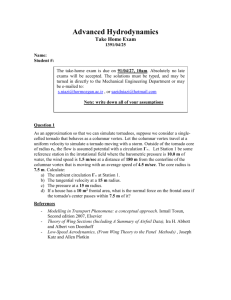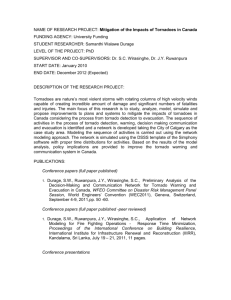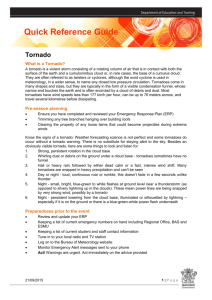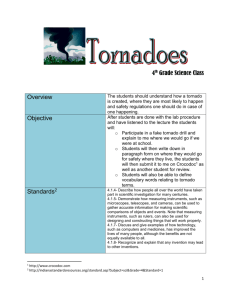detailed description here
advertisement
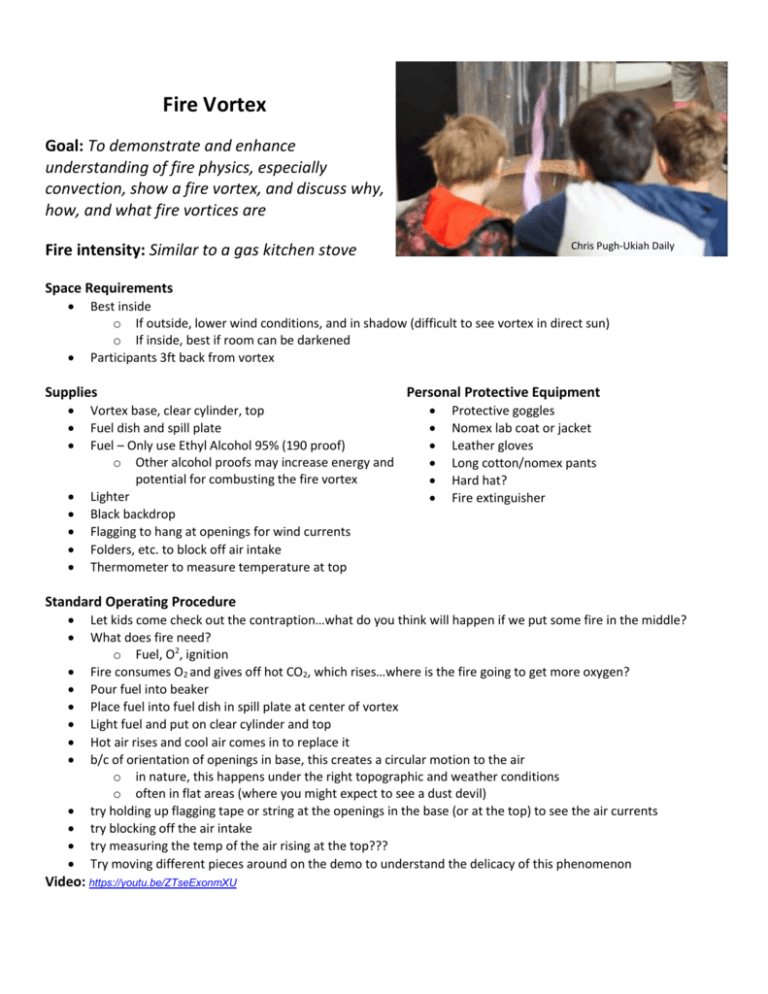
Fire Vortex Goal: To demonstrate and enhance understanding of fire physics, especially convection, show a fire vortex, and discuss why, how, and what fire vortices are Chris Pugh-Ukiah Daily Journal 2015 Fire intensity: Similar to a gas kitchen stove Space Requirements Best inside o If outside, lower wind conditions, and in shadow (difficult to see vortex in direct sun) o If inside, best if room can be darkened Participants 3ft back from vortex Supplies Vortex base, clear cylinder, top Fuel dish and spill plate Fuel – Only use Ethyl Alcohol 95% (190 proof) o Other alcohol proofs may increase energy and potential for combusting the fire vortex Lighter Black backdrop Flagging to hang at openings for wind currents Folders, etc. to block off air intake Thermometer to measure temperature at top Personal Protective Equipment Protective goggles Nomex lab coat or jacket Leather gloves Long cotton/nomex pants Hard hat? Fire extinguisher Standard Operating Procedure Let kids come check out the contraption…what do you think will happen if we put some fire in the middle? What does fire need? o Fuel, O2, ignition Fire consumes O2 and gives off hot CO2, which rises…where is the fire going to get more oxygen? Pour fuel into beaker Place fuel into fuel dish in spill plate at center of vortex Light fuel and put on clear cylinder and top Hot air rises and cool air comes in to replace it b/c of orientation of openings in base, this creates a circular motion to the air o in nature, this happens under the right topographic and weather conditions o often in flat areas (where you might expect to see a dust devil) try holding up flagging tape or string at the openings in the base (or at the top) to see the air currents try blocking off the air intake try measuring the temp of the air rising at the top??? Try moving different pieces around on the demo to understand the delicacy of this phenomenon Video: https://youtu.be/ZTseExonmXU Fire whirls, also known as fire devils, fire tornadoes or firenados, are whirlwinds of flame that may occur when intense heat and turbulent wind conditions combine to form whirling eddies of air. These eddies can tighten into a tornado-like structure that sucks in burning debris and combustible gases. Excerpt from http://en.wikipedia.org/wiki/Fire_whirl Our fire vortex creates similar whirling eddies of air to create the tornado! Ok, what is a fire tornado? A fire tornado consists of a core—the part that is actually on fire—and an invisible pocket of rotating air that feeds fresh oxygen to the core. The core of a typical fire tornado is 1 to 3 feet (0.30 to 0.91 m) wide and 50 to 100 feet (15 to 30 m) tall. Under the right conditions, very large fire tornadoes—several tens of feet wide and more than a thousand feet (300 meters) tall—can form. The temperature inside the core of a fire tornado can reach up to 2,000 °F (1,090 °C)—hot enough to potentially reignite ashes sucked up from the ground. Often, fire tornadoes are created when a wildfire or firestorm creates its own wind, which can turn into a spinning vortex of flame. Combustible, carbon-rich gases released by burning vegetation on the ground are fuel for most fire tornadoes. When sucked up by a whirl of air, this unburned gas travels up the core until it reaches a region where there is enough fresh, heated oxygen to set it ablaze. This causes the tall and skinny appearance of a fire tornado's core. Real-world fire whirls usually move fairly slowly. Fire tornadoes can set objects in their paths ablaze and can hurl burning debris out into their surroundings. The winds generated by a fire tornado can also be dangerous. Large fire tornadoes can create wind speeds of more than 100 miles per hour (160 km/h)—strong enough to knock down trees. Fire tornadoes can last for an hour or more, and they cannot be extinguished directly. They do happen in the real world! • During the 2003 Canberra bushfires, a fire tornado with a diameter of nearly 500 metres (1,600 ft) with horizontal winds exceeding 250 kilometres per hour (160 mph) was documented. Further research into the fires confirmed this in 2012.[2] • In Canberra, wind damage consistent with an F3 tornado on the Fujita Scale was observed, in addition to the fire damage.[3] New research released in 2013 showed that the supercell thunderstorm that caused the tornado originated from the converging winds of firestorm itself, one of the first confirmed observations of an intense thunderstorm forming from a Pyrocumulonimbus cloud.[4] • The Great Peshtigo Fire grew into a firestorm which probably made one or several true tornadoes. Roofs were torn off the houses; even railway wagons were tossed around. • Another extreme example of a fire tornado from other than a vegetation fire is the 1923 Great Kantō earthquake in Japan which ignited a large city-sized firestorm and produced a gigantic fire whirl that killed 38,000 in fifteen minutes in the Hifukusho-Ato region of Tokyo.[5] • Another example is the numerous large fire whirls (some tornadic) that developed after lightning struck an oil storage facility near San Luis Obispo, California on 7 April 1926, several of which produced significant structural damage well away from the fire, killing two. Thousands of whirlwinds were produced by the four-day-long firestorm coincident with conditions that produced severe thunderstorms, in which the larger fire whirls carried debris 5 kilometers away.[6] Excerpt from http://en.wikipedia.org/wiki/Fire_whirl Classifcation There are currently three known types of fire whirls:[7] – Type 1: Stable and centered over burning area. – Type 2: Stable or transient, downwind of burning area. – Type 3: Steady or transient, centered over an open area adjacent to an asymmetric burning area with wind. There is evidence suggesting that the fire whirl in the Hifukusho-ato area, during the Great Kanto Earthquake of 1923, was of type 3.[8] Excerpt from http://en.wikipedia.org/wiki/Fire_whirl Hot videos http://vimeo.com/alicespringsfilmtv/skyfire/ Fire tornado video (whirl) 11 September 2012 Alice Springs Australia. Photo www.abc.net.au/news Australian researchers document world-first fire tornado. Catalyst story: Fire Tornado Another photo www.youtube.com Video of a Fire whirl (0:30), Brazil. “ Rare Footage of Fire Tornado". BBC. 25-Aug-2010 http://www.youtube.com/watch?v=Z21s5PhzZl4 Los Padres National Forest

